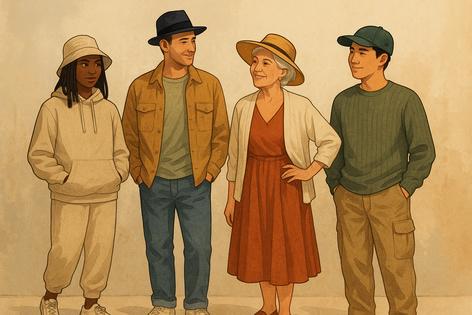Hats in 2025: Fashion, Function and Identity
Published in Fashion Daily News
Hats, once considered relics of a bygone era, have staged a striking comeback in 2025. No longer reserved for special occasions or niche subcultures, headwear has emerged as a daily staple across age groups, cultures and style preferences. From bucket hats and wide-brimmed classics to futuristic smart caps, hats today represent more than mere accessories—they are fashion statements, practical tools and symbols of individuality.
A Pandemic Push Toward Practicality
The resurgence of hats began during the pandemic years, when outdoor activity became the safest social outlet. Wide-brimmed hats and baseball caps protected people not only from the sun but also from the feeling of exposure in public. By 2023, designers had seized on the moment, and hats became fixtures on runways, no longer treated as afterthoughts.
In 2025, the momentum continues. Outdoor lifestyle brands sell hats alongside athleisure apparel, while luxury houses reinterpret classic silhouettes with sustainable fabrics and bold detailing. The result is a marketplace where hats are simultaneously practical and aspirational.
Styles That Define the Year
This year’s most popular styles reflect both nostalgia and modernity. Bucket hats, beloved by Gen Z, remain in rotation but now feature durable textiles such as organic cotton or recycled nylon. Their casual ease makes them versatile for city wear, festivals and travel.
Wide-brimmed straw hats, once tied to beach vacations, have moved inland. Paired with flowy dresses or relaxed linen suits, they signal sophistication and confidence in urban settings. Meanwhile, baseball caps, long a staple of American casual wear, continue to dominate, updated with minimalist logos or eco-conscious branding.
For those seeking drama, structured fedoras and cloches are making selective returns, especially in muted earth tones. These silhouettes offer refinement without excess, appealing to consumers looking to balance classic style with modern restraint.
Sustainability Drives Design
Sustainability remains central to hat design in 2025. Brands increasingly use organic cotton, hemp, bamboo and recycled fibers, appealing to consumers who demand both ethical sourcing and long-term durability. Handmade hats from artisan communities are also gaining traction, valued for their craftsmanship and authenticity.
Even luxury brands are adapting. Leather trims are often replaced with plant-based alternatives, while dyes rely on natural pigments rather than chemical processes. In an era where fashion waste is heavily scrutinized, hats are marketed as timeless investments rather than seasonal novelties.
Smart Hats Enter the Market
Technology has entered the hat space as well. Smart caps equipped with UV sensors, hydration trackers and even discreet headphones are now available. While still niche, these designs represent the growing overlap between fashion and function. Seniors and athletes, in particular, are early adopters, appreciating hats that provide health monitoring while fitting seamlessly into daily wardrobes.
Some smart hats also feature subtle solar panels to charge small devices, combining environmental consciousness with convenience. Though not yet mainstream, the presence of these innovations suggests hats may become hubs of wearable technology in years ahead.
Hats as Identity Markers
Hats in 2025 carry strong cultural and social connotations. For many, wearing a hat is not simply about shielding from the sun but about projecting identity. Streetwear enthusiasts sport flat-brim caps as markers of community, while older generations turn to fedoras or berets to assert elegance and maturity.
Gender-neutral designs dominate many collections, with unisex marketing ensuring hats appeal across demographics. This shift reflects broader changes in fashion, where fluidity and inclusivity are valued over rigid categories.
The Return of Occasion Hats
While casual hats dominate the market, occasion hats have not disappeared. Horse racing events, weddings and cultural festivals continue to showcase extravagant millinery. Designers experiment with sculptural forms, feathers and unconventional materials to keep the tradition alive. Social media amplifies these creations, turning hats into viral art pieces that inspire, even if few will wear them daily.
Challenges of the Trend
Despite their popularity, hats still face challenges. Practical barriers—such as storage, portability and weather—limit their universal adoption. Some critics also argue that hats risk becoming over-saturated, with too many brands chasing the same minimalist baseball cap aesthetic. For consumers, the challenge lies in distinguishing between fast-fashion offerings and investment pieces that will endure.
Celebrity and Influencer Influence
As with many fashion movements, celebrities and influencers have been key to hat culture’s revival. Musicians, actors and athletes frequently appear in public sporting distinctive hats, often paired with casual, everyday outfits. Social media platforms, especially TikTok and Instagram, amplify these looks, encouraging younger consumers to experiment.
Fashion-forward seniors are also influential. Lifestyle influencers over 60 highlight wide-brimmed hats, soft berets and structured caps as age-inclusive fashion, showing that headwear can be both dignified and playful across generations.
The Road Ahead
Looking forward, hats seem poised to remain central to fashion. As climate awareness drives more outdoor living and as technology blends further with apparel, hats will likely expand their practical applications. Simultaneously, their role as cultural and stylistic markers will only grow.
For designers and consumers alike, hats in 2025 are not relics of the past but essential tools of the present. Whether worn for sun protection, personal branding, or sheer self-expression, they prove once again that fashion’s smallest accessories can cast the biggest shadows.
========
This article was created, in part, utilizing AI tools







Comments